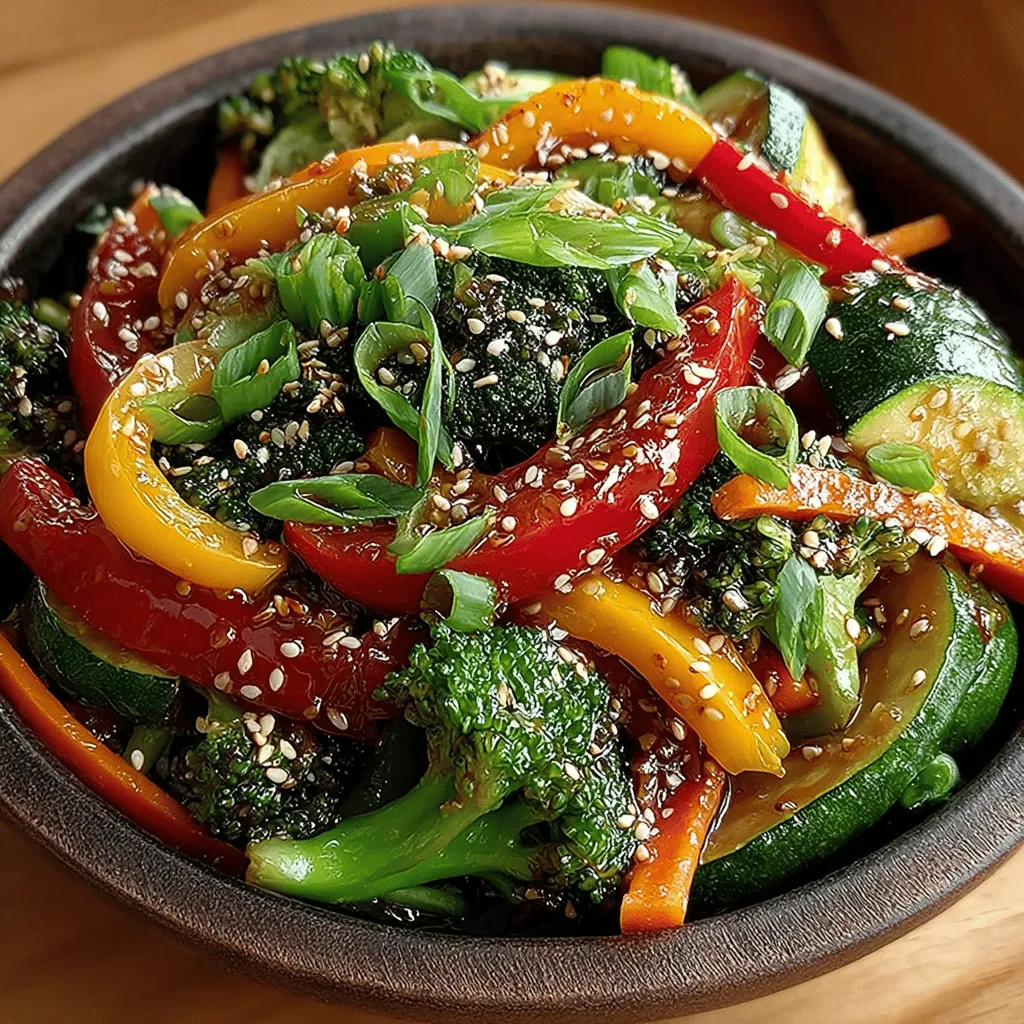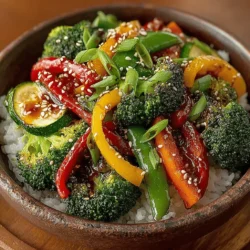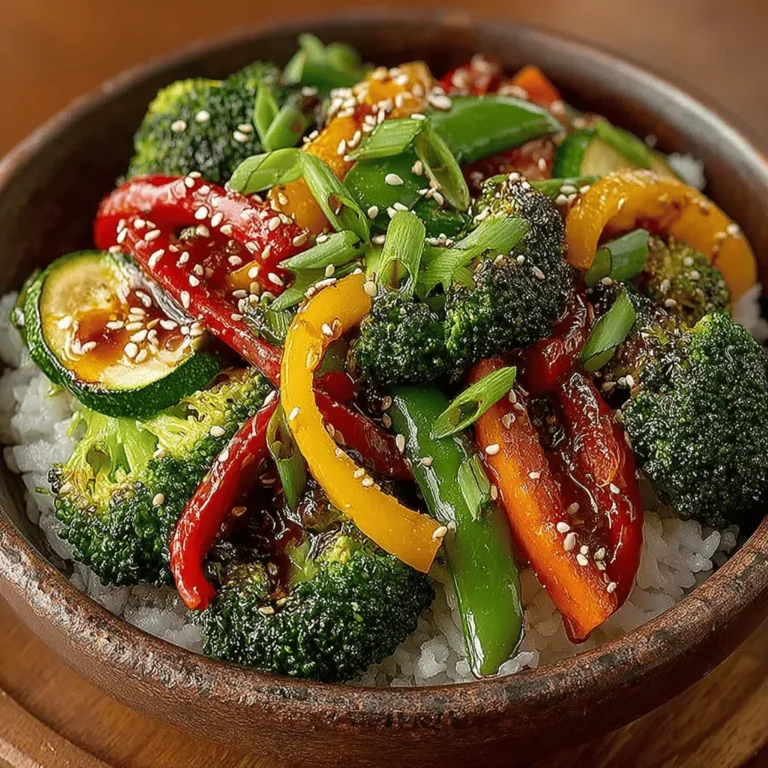Introduction to Quick Veggie Stir-Fry with Teriyaki Sauce
In today’s fast-paced world, home cooks are often on the lookout for meals that are not only nutritious but also quick to prepare. One dish that perfectly fits this criteria is the Quick Veggie Stir-Fry with Teriyaki Sauce. This vibrant and flavorful recipe is designed to deliver a satisfying dinner experience in under 30 minutes, making it an ideal choice for busy weeknights or last-minute gatherings.
Stir-frying is a cooking technique that has its roots in Asian cuisine and is known for its ability to retain the natural flavors, colors, and nutrients of fresh ingredients. With this Quick Veggie Stir-Fry, you can enjoy an array of vegetables that are both delicious and healthy. The dish is versatile, accommodating various dietary preferences, whether you’re vegetarian, vegan, or simply looking to incorporate more plant-based meals into your rotation.
This stir-fry is not just a feast for the eyes; it’s also rich in essential vitamins and minerals. The addition of a savory teriyaki sauce elevates the dish, giving it a touch of sweetness and umami that perfectly complements the freshness of the vegetables. Whether served over rice, noodles, or enjoyed on its own, this Quick Veggie Stir-Fry with Teriyaki Sauce is sure to become a staple in your meal planning.
As we explore this delightful dish, we will dive into the key ingredients that make it shine, discuss their nutritional benefits, and guide you through the initial steps for preparation.
Understanding the Ingredients
Exploring the Nutritional Value of Fresh Vegetables
The beauty of the Quick Veggie Stir-Fry lies in its use of fresh, colorful vegetables. Each vegetable offers its own unique set of health benefits, contributing to a well-rounded meal. Let’s take a closer look at some of the stars of this dish:
– Broccoli: This nutrient-dense vegetable is a powerhouse of vitamins C and K, fiber, and antioxidants. Broccoli is known for its cancer-fighting properties, making it an excellent addition to any meal.
– Bell Peppers: Available in various colors, bell peppers are rich in vitamins A and C, as well as several antioxidants. They add a sweet crunch to the stir-fry and are known to support eye health.
– Snap Peas: These sweet and tender peas are not only delicious but also packed with vitamins A, C, and K, along with fiber. They add a delightful snap to the dish, enhancing both texture and flavor.
– Carrots: A classic stir-fry ingredient, carrots are high in beta-carotene, which the body converts into vitamin A. This nutrient is essential for maintaining healthy vision, skin, and immune function.
– Zucchini: This versatile vegetable is low in calories and high in vitamins A and C. Zucchini absorbs flavors well, making it a fantastic addition to stir-fries.
Together, these vegetables create a colorful and nutrient-packed medley that not only pleases the palate but also nourishes the body.
The Role of Teriyaki Sauce in Flavor Enhancement
No stir-fry is complete without a delicious sauce, and teriyaki sauce is the perfect complement to our veggie medley. Originating from Japan, teriyaki sauce is a sweet and savory blend of soy sauce, mirin (a sweet rice wine), and sugar. The combination of these ingredients provides a rich umami flavor that enhances the natural tastes of the vegetables.
Teriyaki sauce is not only flavorful but also versatile. It can be used as a marinade, a glaze for grilled meats, or as a finishing touch for stir-fries. In this recipe, the teriyaki sauce coats the vegetables, infusing them with a delightful taste and creating a luscious glaze that brings everything together.
Choosing the Right Vegetable Oil for Cooking
When it comes to stir-frying, the choice of oil is crucial. The right oil can significantly impact the flavor and healthfulness of your dish. Since stir-frying involves high heat, it’s important to select oils with a high smoke point. Here are a few oils that are ideal for stir-frying:
– Canola Oil: With a high smoke point and neutral flavor, canola oil is a popular choice for stir-frying.
– Peanut Oil: Known for its slightly nutty flavor, peanut oil has a high smoke point and is often used in Asian cuisine.
– Sesame Oil: While it has a lower smoke point, sesame oil adds a rich flavor and can be used in combination with other oils for a fragrant finish.
– Grapeseed Oil: This oil is light and has a high smoke point, making it suitable for high-heat cooking like stir-frying.
Choosing the right oil not only enhances the flavor of your Quick Veggie Stir-Fry but also contributes to its health benefits, so consider your options carefully.
Preparing the Veggies
Essential Tips for Washing and Chopping Vegetables
To create a truly exceptional stir-fry, proper preparation is key. Start by washing your vegetables thoroughly under running water to remove any dirt or pesticides. For leafy greens like broccoli, it’s particularly important to inspect for any hidden pests.
Once washed, the next step is chopping. Aim for uniform pieces to ensure even cooking. For instance, slice bell peppers into strips, chop broccoli into florets, and cut carrots and zucchini into matchsticks or rounds. This not only helps with even cooking but also enhances the overall presentation of your dish.
The Importance of Uniform Sizing in Cooking
Cutting vegetables into similar sizes is essential in stir-frying. When vegetables are cut uniformly, they cook at the same rate, preventing some pieces from becoming overcooked while others remain underdone. This attention to detail enhances the texture of your dish and ensures that each bite is perfectly balanced.
Furthermore, uniform sizing contributes to the visual appeal of your Quick Veggie Stir-Fry. A colorful array of similarly sized vegetables creates an inviting presentation that makes the dish even more appetizing.
Cooking Techniques for a Perfect Stir-Fry
Understanding the stir-fry method is crucial for achieving the best results. Stir-frying is a quick cooking technique that involves cooking food over high heat while continuously stirring. This method allows for rapid cooking, which helps to retain the vegetables’ crispness and nutrients.
To start, heat your chosen oil in a wok or a large skillet over medium-high heat. Once the oil is shimmering, add your chopped vegetables in order of cooking time; start with the harder vegetables like carrots and broccoli, followed by the softer ones like bell peppers and zucchini. Stir-fry each addition for a few minutes before adding the teriyaki sauce, allowing the flavors to meld beautifully.
By mastering these initial steps and understanding the ingredients involved, you will be well on your way to creating a delicious Quick Veggie Stir-Fry with Teriyaki Sauce that is sure to impress family and friends alike. In the next part of this article, we will delve deeper into the cooking process and provide tips for customizing this dish to suit your taste preferences.

Understanding Stir-Frying and Its Significance in Asian Cuisine
Stir-frying is a popular cooking technique that originated in Asia, particularly in Chinese cuisine. This method involves cooking food quickly at high temperatures in a small amount of oil while stirring continuously. The main significance of stir-frying lies in its ability to preserve the color, texture, and nutrients of the ingredients, making it an ideal choice for preparing fresh vegetables. The quick cooking time ensures that the vegetables remain crisp and vibrant, allowing their natural flavors to shine through.
One of the key benefits of stir-frying is its efficiency. In a matter of minutes, you can create a delicious and wholesome meal that is not only satisfying but also packed with nutrients. This technique also allows for versatility, as you can easily adapt the recipe to include your favorite vegetables or proteins. Stir-frying is not just a cooking method; it’s a way to celebrate the freshness and diversity of ingredients, making it a staple in many kitchens around the world.
Mastering the Heat: Why Temperature Matters
When it comes to stir-frying, mastering the heat is crucial for achieving that perfect tender-crisp texture. The high temperature used in stir-frying helps to sear the vegetables quickly, locking in moisture and flavor while preventing them from becoming soggy. The ideal heat level for stir-frying is medium-high to high, which allows for rapid cooking without burning the ingredients.
Using a well-seasoned wok or a heavy skillet can make a significant difference in heat retention and distribution. A hot pan will help create a beautiful char on the vegetables, enhancing both the taste and appearance of your dish. Always preheat your cooking surface before adding any ingredients, ensuring that the oil shimmers and is hot enough to start cooking immediately. This attention to temperature will elevate your stir-fry to restaurant-quality levels.
Aromatics: The Backbone of Flavor
Aromatics play a pivotal role in building the flavor base of your Quick Veggie Stir-Fry with Teriyaki Sauce. Garlic and ginger are two essential ingredients that not only add depth to the dish but also provide numerous health benefits. Garlic is known for its immune-boosting properties, while ginger aids digestion and adds a warm, spicy note.
To maximize the flavor of these aromatics, it’s important to add them at the right time during cooking. Adding garlic and ginger at the beginning of the stir-frying process allows their flavors to infuse the oil and coat the vegetables as they cook. This creates a fragrant aroma that tantalizes the senses and enhances the overall taste of the dish.
Step-by-Step Cooking Instructions
Detailed Breakdown of Each Cooking Step
1. Prepare Your Ingredients: Start by washing and chopping all your vegetables into bite-sized pieces. This not only ensures even cooking but also makes the stir-frying process seamless and efficient.
2. Heat the Oil: In a large wok or a non-stick skillet, heat 2 tablespoons of vegetable oil over medium-high heat. Wait until the oil is shimmering before adding the aromatics.
3. Add the Aromatics: Once the oil is hot, add 2 cloves of minced garlic and 1 tablespoon of grated ginger to the pan. Stir-fry for about 30 seconds until fragrant, being careful not to burn them.
4. Incorporate the Vegetables: Next, add your prepared vegetables. Start with the denser vegetables like bell peppers and carrots, followed by broccoli, snap peas, and any other quick-cooking vegetables. Stir-fry for about 3-4 minutes, or until they begin to soften but still retain their crunch.
5. Add the Teriyaki Sauce: Pour in 1/3 cup of teriyaki sauce, stirring well to coat all the vegetables evenly. Cook for an additional 2-3 minutes, allowing the sauce to heat through and thicken slightly.
6. Finish with Optional Add-ins: If you are using tofu or cooked protein, add it to the pan at this stage. Stir well to combine and heat everything through.
7. Serve Immediately: Remove the stir-fry from heat and serve hot over your choice of rice or noodles.
Timing is Everything: How Long to Cook Each Vegetable
Achieving the perfect doneness for your vegetables is all about timing. Here’s a quick guide on how long to cook each vegetable to maintain their texture and nutrients:
– Bell Peppers: 3-4 minutes
– Carrots: 4-5 minutes
– Broccoli: 2-3 minutes
– Snap Peas: 2-3 minutes
– Zucchini: 2-3 minutes
– Mushrooms: 3-4 minutes
By following these time guidelines, you can ensure that each vegetable is cooked to perfection—tender yet still crisp, bursting with flavor and color.
Serving Suggestions for Your Veggie Stir-Fry
Creative Ideas for Pairing with Rice or Noodles
When it comes to serving your Quick Veggie Stir-Fry with Teriyaki Sauce, you have a wealth of options. Here are some creative ideas for pairing:
– Rice Options: White rice, jasmine rice, and brown rice are classic choices. For a healthier alternative, consider using cauliflower rice or quinoa, which provide a nutrient-dense base for your stir-fry.
– Noodle Options: Udon noodles, rice noodles, or soba noodles can elevate your dish’s texture and taste. For a gluten-free option, choose rice noodles or zucchini noodles for a low-carb twist.
Garnishing for Presentation
Presentation is key to making your meal visually appealing. Here are some garnishing ideas to enhance the look of your dish:
– Sesame Seeds: Sprinkle toasted sesame seeds over the stir-fry for a nutty flavor and a delightful crunch.
– Green Onions: Thinly slice green onions and use them as a fresh garnish. Their vibrant color adds a pop to your dish and a mild onion flavor.
– Chili Flakes: For those who enjoy a bit of heat, a sprinkle of red chili flakes or sliced fresh chilies can add an exciting kick.
Conclusion: The Joy of Quick and Healthy Cooking
The Quick Veggie Stir-Fry with Teriyaki Sauce is not just a meal; it’s an invitation to enjoy the simplicity and joy of cooking at home. This recipe highlights the benefits of preparing healthy meals that are both quick and delicious, allowing you to savor the flavors while nourishing your body.
Cooking at home not only saves money but also provides you with the opportunity to control the ingredients and portion sizes. You can experiment with different vegetables and sauces, making each stir-fry a unique creation tailored to your taste preferences. Whether you’re making a quick weeknight dinner or impressing guests with a colorful spread, this stir-fry is a versatile dish that fits any occasion.
So, embrace the versatility of stir-frying, explore your favorite vegetables, and enjoy the flavorful adventure that awaits in your kitchen. Remember, healthy eating doesn’t have to be time-consuming or complicated; with a quick stir-fry, it can be an exciting culinary experience ready to be explored.


